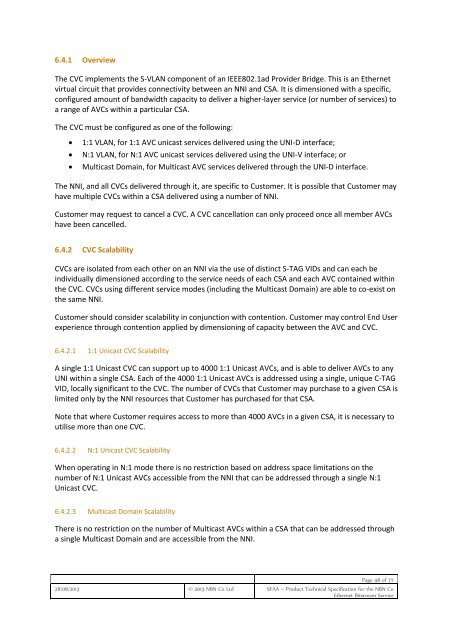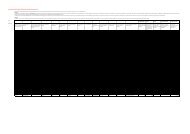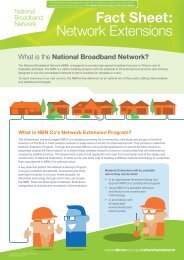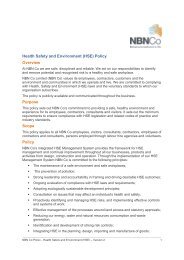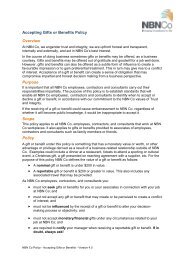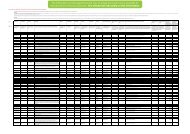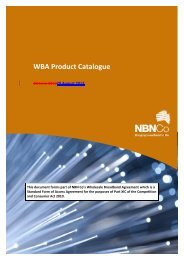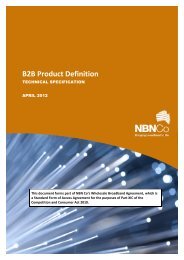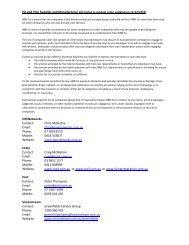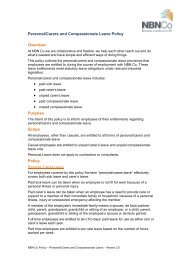Download (PDF - 1.4 MB) - NBN Co
Download (PDF - 1.4 MB) - NBN Co
Download (PDF - 1.4 MB) - NBN Co
You also want an ePaper? Increase the reach of your titles
YUMPU automatically turns print PDFs into web optimized ePapers that Google loves.
6.4.1 Overview<br />
The CVC implements the S-VLAN component of an IEEE802.1ad Provider Bridge. This is an Ethernet<br />
virtual circuit that provides connectivity between an NNI and CSA. It is dimensioned with a specific,<br />
configured amount of bandwidth capacity to deliver a higher-layer service (or number of services) to<br />
a range of AVCs within a particular CSA.<br />
The CVC must be configured as one of the following:<br />
<br />
<br />
<br />
1:1 VLAN, for 1:1 AVC unicast services delivered using the UNI-D interface;<br />
N:1 VLAN, for N:1 AVC unicast services delivered using the UNI-V interface; or<br />
Multicast Domain, for Multicast AVC services delivered through the UNI-D interface.<br />
The NNI, and all CVCs delivered through it, are specific to Customer. It is possible that Customer may<br />
have multiple CVCs within a CSA delivered using a number of NNI.<br />
Customer may request to cancel a CVC. A CVC cancellation can only proceed once all member AVCs<br />
have been cancelled.<br />
6.4.2 CVC Scalability<br />
CVCs are isolated from each other on an NNI via the use of distinct S-TAG VIDs and can each be<br />
individually dimensioned according to the service needs of each CSA and each AVC contained within<br />
the CVC. CVCs using different service modes (including the Multicast Domain) are able to co-exist on<br />
the same NNI.<br />
Customer should consider scalability in conjunction with contention. Customer may control End User<br />
experience through contention applied by dimensioning of capacity between the AVC and CVC.<br />
6.4.2.1 1:1 Unicast CVC Scalability<br />
A single 1:1 Unicast CVC can support up to 4000 1:1 Unicast AVCs, and is able to deliver AVCs to any<br />
UNI within a single CSA. Each of the 4000 1:1 Unicast AVCs is addressed using a single, unique C-TAG<br />
VID, locally significant to the CVC. The number of CVCs that Customer may purchase to a given CSA is<br />
limited only by the NNI resources that Customer has purchased for that CSA.<br />
Note that where Customer requires access to more than 4000 AVCs in a given CSA, it is necessary to<br />
utilise more than one CVC.<br />
6.4.2.2 N:1 Unicast CVC Scalability<br />
When operating in N:1 mode there is no restriction based on address space limitations on the<br />
number of N:1 Unicast AVCs accessible from the NNI that can be addressed through a single N:1<br />
Unicast CVC.<br />
6.4.2.3 Multicast Domain Scalability<br />
There is no restriction on the number of Multicast AVCs within a CSA that can be addressed through<br />
a single Multicast Domain and are accessible from the NNI.<br />
Page 48 of 77<br />
28/08/2013 © 2013 <strong>NBN</strong> <strong>Co</strong> Ltd SFAA – Product Technical Specification for the <strong>NBN</strong> <strong>Co</strong><br />
Ethernet Bitstream Service


